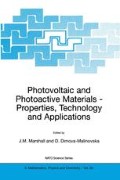Abstract
In the search for higher photovoltaic (PV) conversion efficiencies, multiple band gap concepts have received increased theoretical attention in the last few years. Many dual band gap systems are based on the semiconductor couple GexSi1-x/Si. However, this is not the optimum theoretical pairing for maximum system efficiency, because of both economic and technological criteria. The Si cell may work at a moderate concentration of infrared light which would be unconverted by GaAs (energy lower than about 1.5 eV). However, by changing the basic solar cell material from Si to a GexSi1-x alloy, with the least possible modification, solar technology can fully profit from present knowledge and future improvements [1–4].
Access this chapter
Tax calculation will be finalised at checkout
Purchases are for personal use only
Preview
Unable to display preview. Download preview PDF.
References
Luque, A. and Araujo, G.L (1990) Physical Limitations to Photovoltaic Energy Conversion, Adam Hilger, Bristol.
Ruiz, J.M., Casado, J. and Luque, A. (1994) Assessment of crystalline GexSi1-x infrared solar cells for dual bandgap PV concepts, Proc. 12th European Photovoltaic Solar Energy Conference, Amsterdam, The Netherlands, 572–574.
Noel, J.P., Rowell, N.L., Houghton, D.C. and Perovic, D.D. (1990) Intense photoluminescence between 1.3 and 1.8 μm from strained Si1-xGex alloys, Appl. Phys. Lett. 57, 1037–1040.
Pearsall, T.P. (1988) The physics and applications of Ge-Si strained layer superlattices, Rev. Solid State Science 1, 505–513.
Tauc, J. (1966) Photoelectric and Thermoelectric Phenomena Semiconductors, PWN, Warsaw (in Polish).
Boncz-Brujewicz, W.L. and Kalasznikow, S.G. (1985) Semiconductor Physics, PWN, Warsaw (in Polish).
Author information
Authors and Affiliations
Editor information
Editors and Affiliations
Rights and permissions
Copyright information
© 2002 Springer Science+Business Media Dordrecht
About this chapter
Cite this chapter
Pociask, M.M., Kąkol, T., Sheregii, E.M., Pociask, M.A., Tomaka, G.M. (2002). Enhancement Of The Photovoltaic Efficiency Of Ge0.2Si0.8/Si Photodiodes. In: Marshall, J.M., Dimova-Malinovska, D. (eds) Photovoltaic and Photoactive Materials — Properties, Technology and Applications. NATO Science Series, vol 80. Springer, Dordrecht. https://doi.org/10.1007/978-94-010-0632-3_21
Download citation
DOI: https://doi.org/10.1007/978-94-010-0632-3_21
Publisher Name: Springer, Dordrecht
Print ISBN: 978-1-4020-0824-5
Online ISBN: 978-94-010-0632-3
eBook Packages: Springer Book Archive

